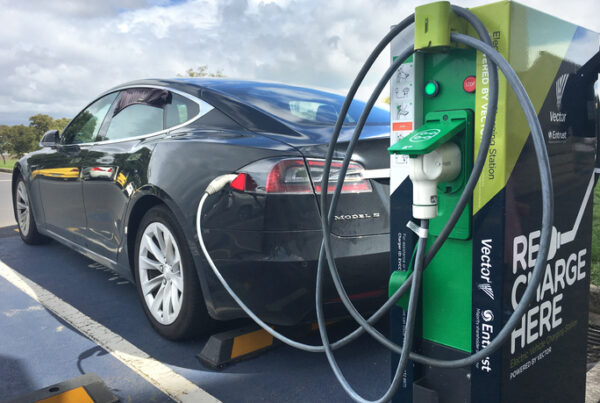It was a real thrill to collaborate with the RACV for a fleet driver safety session in Melbourne last Thursday led by experienced facilitator Julia Sheppard. The session delivered a great turnout and served as an important reminder of the need for continued driver training – even among your most experienced drivers.
Within the 2-hour intensive program, Julia covered a range of topics from updated road rules, driver responsibility, mobile phone use to considering the huge contribution that work-related driving provides to Australia’s annual road toll.
“Approximately one-third of the vehicles on the road are used for business purposes – and on average business, vehicle drivers travel three times the distance of private drivers,” Julia said.

Fleet managers and industry professionals from across Melbourne gathered at RACV
Startling research has revealed that 20 per cent of business vehicles are involved in crashes, and concerningly 60 per cent of the time it is the fault of the fleet driver. The current economic cost of road casualty crashes is currently estimated to exceed $27B p/a and the figure is only certain to increase as more vehicles and drivers enter the market.
Perhaps most concerning of all is that one-third of work-related deaths involve a motor vehicle. In layman’s terms – fleet and private vehicles can be a deadly weapon even in the safest hands!
And legally, ethically and morally fleet professionals are responsible for the welfare of their drivers in the mobile workplace.

Facilitator Julia Sheppard begins her presentation
“Your vehicles are legally considered as a workplace under changes to the Chain of Responsibility whether you like it or not,” Julia said. “There is a obligation there for fleet managers.”
So, what can some practical ways that the industry can collectively improve their commitment to safety?
1. Curb driver distraction
If you were asked how much of every minute that drivers actually pay attention to the road in front of them what would you say? 30 seconds maybe? 15 seconds perhaps?
8 seconds is the answer. And the reality presented to attendees from Julia painted a scary picture for any driver to consider.
“I’m asking you to think about not only your own driving but what can you put in place that is going to raise the awareness from your staff to reduce their risk within your organisation,” she said.
“Often your employees, when they are driving for your organisation forget that driving is a part of their job and that they should show the same diligence to that as they do the other aspects of their role.”
2. Understand the effects of speed
The average human reaction speed is 1.5 seconds so leaving a 3-second gap between cars should be a minimum. Julia told attendees that an impact rate of 32km/h is often the threshold between a minor injury or a significant injury for an unprotected pedestrian, cyclist or motorcyclist.
Slight increases in speed can have a massive difference in braking distances and impact speeds so drivers should be encouraged to think twice before speeding or attempting unnecessary overtaking on rural roads.
“One-quarter of deaths on Australian roads are due to low-level speeding on our roads – just 5km/h faster than the speed limit,” she said.
The popular TAC Wipe Off 5 campaign rings true even today and should serve as an excellent reminder of the need to slow down and consider other road users.
3. Know the limitations of modern technology
While modern vehicles have increased the number of electronic aids available to drivers, they do not replace good fundamental driving practices. Rear-sensor cameras while helpful don’t replace a working set of human eyes. While reversing make sure to use all your mirrors, check your blind spots and never assume anything.
Julia also took the opportunity to highlight the dangers that airbags can present in a serious incident – with standard airbags manufactured to deploy at a scary 380 km/h. Sitting too close to the steering wheel, or having your hands fixed to unorthodox parts of the wheel can have harmful or even deadly effects for a driver or passenger.
Current industry recommendations suggest that drivers hands should now be positioned at 9 o’clock and 3 o’clock on their steering wheel, and a minimum distance of 30cm be maintained between upper body and airbag to reduce injury.
4. Don’t drive when you’re not alert
Driving tired is believed to be a factor in about 25% per cent of road crashes. If you’re awake for 17 hours –you have the equivalent reaction times as someone with a blood alcohol content of .05. Take regular breaks at least every two hours and don’t drive during hours when you would normally be asleep wherever possible (ie – between midnight-6am).
“You are most likely to fall asleep within close proximity of your home or final destination – people just don’t think about fatigue at this point and their mind switches off,” Julia said.
Statistics have also shown that crash rates increase significantly after 2pm each day, so make an effort to cater that into your planning where possible for your fleet. This is particularly invaluable information for those working in the transport and heavy vehicle industries.
5. For goodness sake, just put down the mobile phone!
As it stands mobile phone use is the leading cause of death in motor vehicle accidents so it would be advisable for fleets to consider crafting a clearly defined mobile phone policy for their drivers.
Consider limiting your on-road communications to emergencies, or even instructing your drivers not to answer calls at all unless they pull over and turn off the vehicle. When asked what difference a phone call has to simply talking with a passenger in the cabin, Julia was quick to acknowledge the constrast.
“The research shows that a conversation with someone beside you is less distracting than a Bluetooth phone call – and there is a simple reason why this is the case” she said.
“Normal conversations have ebbs and flows that often match the conditions that are happening within and around the vehicle, whereas mobile phone conversations are more dangerous because the person at the other end can’t see what is happening with the driver.”
Enforce leadership and keep your fleet safe by taking mobile phone use seriously, particularly among younger drivers within your fleet.

AfMA would like to thank all who attended the gathering in Melbourne on July 26th and for our engaging speaker Julia Sheppard and the entire RACV team for their support. AfMA organises multiple Professional Development Forums throughout Australia in VIC, NSW, QLD, WA, TAS and Auckland, New Zealand.




















